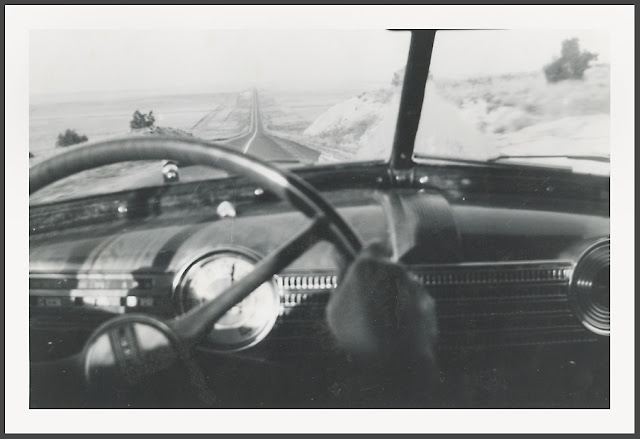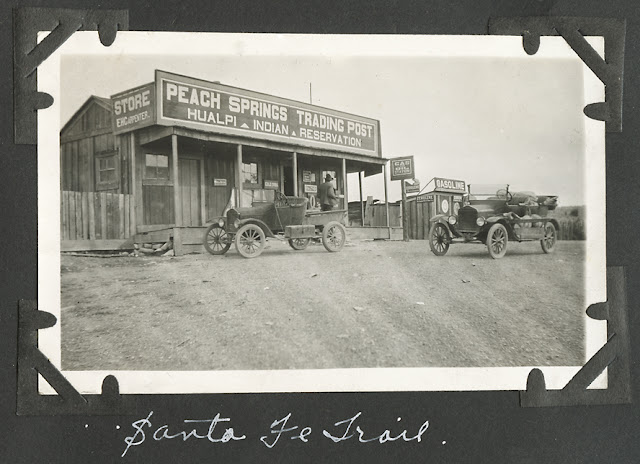Tuesday, June 28, 2011
Tuesday, June 21, 2011
Here Comes Tomorrow - 1948
9:55 PM
No comments
1947-8 Studebaker Starlight Coupe
A thoroughly modern postwar girl in a stylish ride, with Dad back in the turret, enjoying the view. Design was apparently tweaked in secret late-night sessions in Virgil Exner's basement while his associates in Raymond Loewy's South Bend studio worked on the official proposal - Studebaker Engineering VP Roy Cole's attempt to maneuver the flamboyant and expensive Frenchman out of the picture.
One Davis Divan of approximately seventeen, in its back-lot curiosity phase, as company founder Gary Davis served out a two year sentence for grand theft and fraud in North County Correctional Facility near Castaic, California. Built in Van Nuys, most were powered by four cylinder Continental engines, although at least one was fitted with a Ford V8-60.
1949-54 Jaguar XK120
William Lyons' luminous pouncing cat in a suitably elegant setting. From Design Museum.org, "In October 1948 Lyons unveiled the Jaguar XK120 – or Super Sports – at the Earls Court Motor Show in London. To the war-weary British public in an era of rationing and the Utility Scheme, the pure lines and voluptuous curves of the two-seater sports car were breathtaking. Equally impressive was the luxurious interior with a walnut-trim dashboard and thick-pile carpet, and the six cylinder engine designed by Heynes and Wally Hassan with a hemispherical head, twin overhead camshafts and top speed of 126 mph. Lyons oversaw every detail of the car’s design, down to the stylishly skinny cross-ply tyres. Sought after by movie stars like Clark Gable, Jaguar sold over 12,000 of the XK120 from 1949 to 1954."
1947-8 Frazer
Frazermania comes to the good street in your neighborhood. Design was taken from a quarter-scale metal mock-up Howard 'Dutch' Darrin cobbled together in 1945 to interest investors in a postwar Graham-Paige. As Darrin explains in Richard M. Langworth's The Last Onslaught On Detroit, "Thinking the scale model was just a stock-seller, I didn't take it seriously. By the time I returned to Detroit it had been built up from full-sized clays into a wooden die model. I even tried to chip away at the thing with some wood tools when I realized how far along it was, but they chased me away." Instead, alterations came from the engineering firm hired to prepare for production, who raised the roofline and eliminated the gentle arc and dip of Darrin's side elevation, restored to the Frazer, Kaiser and Henry J for 1951. Proposal photo from Langworth book.
1946-8 Crosley
First postwar edition of Cincinnati industrialist Powel Crosley's pint-sized economy car, originally sold by independent appliance dealers and department stores, huddled against the curb somewhere in Southern California. Its distinction as America's first slab sided production car may have something to do with its manufacturer's experience stamping sheet metal for Shelvador refrigerators. Struggling for acceptance in a boomtown America focused on power and prestige, Crosley stopped building cars in 1952.
1948 TASCO
Gordon Buehrig's design for an all-American sports car, built by Derham on a reworked 1948 Mercury chassis with Edelbrock dual carb manifold and OHV conversion on its flathead V8. Ten investors contributed $5000 each to the project, initially a sort of king-sized MG TC for the postwar boom. Buehrig argued for a closed cabin, citing parallels in private aircraft where the open cockpit, with its helmets and goggles, noise and windblast, fell from favor after Charles Lindbergh flew solo across the Atlantic in a business suit. When you did want the wind in your hair, you simply removed T-top panels like those introduced on the Corvette twenty years later. One investor's insistence that the fiberglass fenders turn with the front wheels added complication and delay, while essential style markers like disappearing headlights were deleted as funds dwindled. The result was an odd duck that had trouble making friends, with Buehrig eventually deeming the car his personal Edsel (horse collar and all). But its patent drawings lead me to believe the TASCO could have made a very different impression with a little more refinement, i.e. time and money. More Plymouth Prowler, less Eastern Bloc. Here we are in the weeds along a two-lane highway, possibly in Northern Indiana during Buehrig's time in South Bend. Patent drawings from Rolling Sculpture - A Designer And His Work, Gordon M. Buehrig with William S. Jackson.
1947-8 Cisitalia 202
The MG TC next space over has a bigger engine, as Pininfarina's template for the modern GT uses a modified Fiat mill of just 1100cc. I saw a ragtop variant at the ACD Museum in Auburn some years ago, glowing a beautiful moss green and roughly the size of a large peanut. Word that it had come from a NASCAR driver made me wonder what kind of ribbing he endured when racing buddies found out his vintage Italian sports car was packing 52hp. But the Cisitalia was a masterful example of the classic fastback GT before there was such a thing, lovingly sculpted, with a baby Buick grille and turbine blade hubcaps that predate turbine blade hubcaps. What would the exclusive Eldorados, Continentals, Adventurers, Furys and Golden Hawks of the mid-fifties have worn without them?
The Cars of Tomorrow 1948
Featuring the Davis, TASCO and Jack Norvell whatsit, a startling creation built in Los Angeles from a Chrysler driveline and various aircraft bits. It appeared in the August 1946 issue of Popular Science, Norvell claiming to have reached 131 mph in testing.
Riverside Special c.1939
3:25 AM
No comments
Bankrolled by Hank O'Day, owner of a Charleston, Illinois tavern that featured an open-secret gambling room with slots just up the stairs. From Bob Lawrence's Vintage Auto Racing Web Ring, "O’Day had owned other big cars before he commissioned Louis 'Curley' Wetteroth, a noted racing car chassis builder in Southern California, to build a new 270 cubic inch Offenhauser powered big car over the winter of 1937 and 1938. The creation was white, trimmed in red scallops, and sported a black number 15 on the tail. It had the best of everything and no expense was spared. Among the unusual extravagances were a chrome frame, chrome running gear, individually chromed spokes in each wheel, a polished aluminum grill and instrument panel. The O’Day Offy was truly a showpiece and the talk of the racing community nationwide before it ever turned a wheel on a racetrack. It was said to have been the most expensive big car ever built, setting O’Day back somewhere in the neighborhood of $20,000. To complete the package, O’Day had a 1938 Diamond-T truck custom built for another $20,000 or so to haul the car around. The truck boasted a partially enclosed bed and sleeping quarters for the crew, rare amenities in the 1930s. O’Day took the car on the road, campaigning it on the American Automobile Association (AAA) Eastern Racing Circuit and in races sanctioned by the Central States Racing Association (CSRA). Johnny McDowell and Joie Chitwood shared driving duties for much of the 1938 racing season, bringing the car home in second place in CSRA points. Early in 1939, Chitwood persuaded track announcer and good friend Jack Story to have Sam Nunis set up sponsorship for the O’Day Offy with Ward’s Riverside Tires. Nunis was the East Coast representative for Riverside and the name “Riverside Special” replaced “O’Day Special” on the car’s cowl." I'm assuming this is the right car. None of the many photos that accompany the borrowed text show the car with vertical grill bars or an exhaust configuration with manifold stacks and tailpipe on one level, nor is there any mention of the car running as #5...
Sunday, June 19, 2011
Dornier Do-X Flugschiff 1929
5:51 PM
No comments
The largest aircraft of its day, the Dornier Do-X Flugschiff (flying ship) was powered by twelve Curtiss Conqueror V12s mounted back to back on a small auxiliary wing above a 157' X 31' main wing. Built to test the market for a transatlantic luxury liner of the sky, the triple decker's passenger accommodations included sleeping quarters, writing rooms, wet bar, lounge, kitchen and 60 foot dining salon. Cockpit, navigation center, engine control and radio rooms were one level up, with fuel tanks and float chambers filling the basement. Setting out for New York late in 1930 via Portugal, the Canary Islands, Guinea-Bissau, Cape Verde Islands, Brazil, Trinidad, Puerto Rico, Florida, South Carolina and Virginia, there was little question of the craft's major shortcoming - cruising at a little over 100 mph, the 50 ton Do-X burned through 400 gallons of fuel every sixty minutes. Attempts to increase efficiency seem to have included early experiments with air cushion ground effects. As passenger E.C. Gordon wrote of his first take off, "Almost immediately the engines were throttled, and the ship began to lose height, and one was convinced that a landing was going to be made, so close to the water did the ship appear to return, but in actual fact a height was set of ten metres, and at this height we went across the North Sea, for, as Capt. Christiansen said, what is the object of flying high—it only wastes power and fuel. Thirty feet on an ordinary aircraft gives you an impression of being up in the air, but thirty feet in the Do.X makes you feel all the time that the next wave will gently lap against the bottom of the boat." Following a series of mishaps and delays including a three month layup in the Canaries after a tarpaulin fire consumed most of the port side wing, the giant finally splashed down in the Hudson River on 27 August 1931, nearly nine months after departing Friedrichshafen. By this time the engines needed major rebuilds, so the Do-X spent another nine months dry docked at Glenn H. Curtiss Airport (now LaGuardia), where thousands of sightseers paid a quarter each to tour the interior and the featured photo was taken. Although 200,000 cheering Berliners welcomed the flying ship home on 24 May 1932, financially strapped Dornier passed it to Lufthansa, who tried it out along the German coast that summer. A 1933 Vienna-Budapest-Istanbul grand tour ended when the tail section broke off during a botched landing at a reservoir in Lower Bavaria. With the continuing global depression making commercial viability unlikely, the repaired aircraft was decommissioned in 1934, becoming a centerpiece of the Deutsche Luftfahrtsammlung aviation museum, which opened in Lehrter Bahnof in 1936 only to be destroyed in an RAF bombing raid in late November 1943, Do-X and all. Dornier actually built the slightly larger Fiat V12 powered Do-X2 and Do-X3 for SANA, Italy's state airline. Launched in 1931 and 1932, the pair were based at a seaplane station at La Spezia on the Ligurian Sea, destined for luxury service between Genoa and Gibraltar before being requisitioned by the Italian Air Force 'for prestige flights and public spectacles'.
Wednesday, June 15, 2011
Tuesday, June 14, 2011
Happy Journey
11:21 PM
No comments
1962 promotional film of Czech racing driver Jaroslav Pavelka tossing a Tatra 603 around over field and stream, town and hillside, accompanied by a party official in line for new wheels and his lovely daughter. The wave of shock and awe as the thing roars past means its pilot can do pretty much whatever he wants, blowing by lesser vehicles on the highway at twice their speed, endangering motorcycles and horse carts, old ladies and bikes as he fishtails through the crooked narrow cobblestone streets of the old city, blasting up into snowy elevations and back, then executing a very neat trick involving a steep grassy slope for a finale. Not even the hapless policistů who give chase in their Tatra T201 patrol wagon can resist stepping forward to shake his hand at the end of his run. YouTube embed courtesy of TopSpeed automagazín.
Subscribe to:
Posts (Atom)
























































